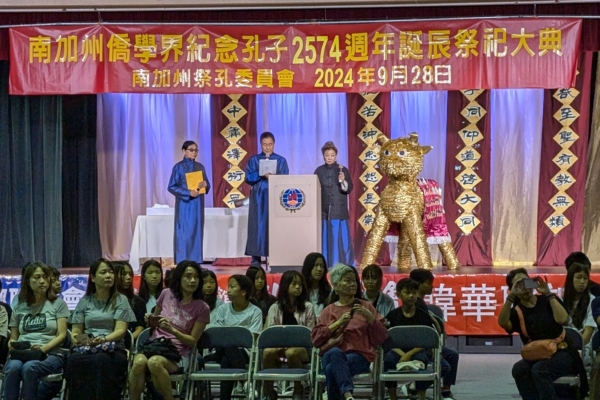Under the solemn drumbeats of the initiation, midway, and final phases, the attendants and 36 dancers entered the venue in a dignified and solemn manner following the rhythm of “five steps and a pause”. On September 28th (Saturday), the overseas Chinese community in Southern California held a grand Confucius ceremony at the Los Angeles Chinese Cultural Center to promote Chinese culture and inherit the Confucian tradition.
To commemorate the 2574th birthday of Confucius, various Southern California overseas Chinese organizations such as the American Confucius and Mencius Society, the Los Angeles Chinese American Association, the California Taiwan Association, the Southern California Qi-Lu Association, the Southern California Korean-Chinese Association, the Los Angeles Overseas Chinese Emergency Rescue Association, the Southern California Chinese School Association, and Vietnamese-Cambodian-Lao Chinese groups organized the “Ji Kong Grand Ceremony” in accordance with ancient rituals. Overseas youth cultural ambassadors (FASCA) presented a performance of the Sixfold Rite.
Chen Minyong, the director of the Los Angeles Chinese Center, emphasized that the significance of the Confucius ceremony lies not only in promoting Chinese culture but also in propagating Confucius’ educational philosophy, especially his spirit of “teaching without discrimination”, which is still highly commendable today. On the occasion of Teachers’ Day, Chen Minyong expressed heartfelt gratitude to all overseas Chinese language teachers for their continuous efforts in promoting Chinese education abroad, providing second and third-generation Chinese descendants with the opportunity to learn about Chinese culture and language overseas.
Following the Confucius ceremony, a teacher award ceremony was held to recognize three outstanding teachers who have made significant contributions to overseas Chinese education: Wang Jingyi, principal of the Southern California Los Angeles West Chinese School, Li Pinyin, a teacher at the St. Mary’s Chinese School, and Hu Jialu, a teacher at the Xiruidu Chinese School. The organizers also presented certificates of appreciation to FASCA youth volunteers and many staff members, acknowledging their efforts in the preparation and execution of the grand ceremony.
Che Qingyu, the newly appointed president of the Southern California Chinese School Union, believes that FASCA youth volunteers have gained a deeper understanding of Confucianism and Confucius’ ideology through the Confucius ritual, enhancing their sense of cultural identity. Various Chinese schools in Southern California have also designed related learning courses to complement the Confucius ceremony.
The Confucius ceremony officially commenced at 1:00 pm led by Sun Huayi and Wang Hu as the announcers, following traditional etiquette. Eight attendants carried red silk plates to welcome the spirit of Confucius into the hall, accompanied by solemn music. The 36 dancers and attendants then performed three bows.
Kong Xianzhao, the 72nd generation descendant of Confucius, and Chen Minyong served as the chief sacrificers, with school principals from various Southern California Chinese schools and many overseas Chinese leaders serving as accompanying and offering officials during the ceremony, completing the rituals of “initial offering”, “subsequent offering”, “in-place offering”, and “final offering” before sending off the deity and restoring the order, thus concluding the Confucius ritual.
For the first time after the pandemic, the organizers reinstated the “Pulling Wisdom Hair” event, inviting the audience to come up on stage and receive “wisdom hairs”. In ancient times, the activity involved pulling hairs from the ears, eyes, and forehead of the sacrificial ox, symbolizing enhanced senses. Adapting to the circumstances, the organizers used a golden statue of a bull and watercolor brushes instead of a sacrificial ox, giving the Southern California locals the chance to participate in the ancient ritual of “Pulling Wisdom Hair” to receive blessings and adding a touch of fun and cultural significance to the ceremony. ◇

